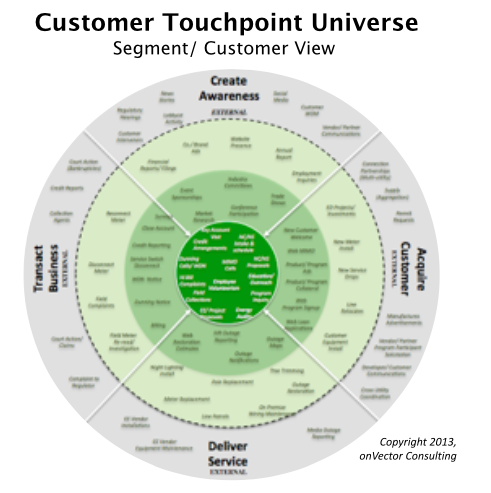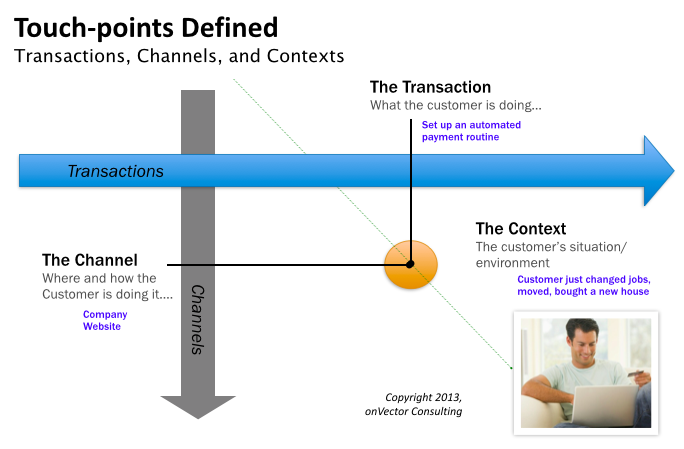
Customer touchpoints have always been the ground zero where Cx battles are won and lost. For years, even long before the Cx “movement” made the term touchpoint a part of the corporate lexicon, Customer Service organizations have been obsessed with improving these targeted areas where our customers transact business with us.
And for years, we’ve invested enormous sums of money trying to measure, analyze, and improve our customer touchpoints. Customer research, satisfaction surveys, training programs, systems investments, process improvements, and the myriad of other “projects” we take on in our annual business plans are in large measure focused on what we believe are our most important customer interactions. And today, they are the central focus of our new Cx initiatives, whether it’s the mapping of customer journeys within and across these interactions, or the creation of new products, channels and communication strategies to enhance those experiences.
Yet ironically, with as much focus as we’ve placed on the proverbial “touchpoint” over the years, and with as much consensus as there is on how to improve them, there still exists little universal alignment across the Cx community at large on what exactly a touchpoint is. And without that, one can only hope we are spending our resources on improving the right things that will yield the right kind of outcomes.
Lack of Definition = Lack of Focus
When I start working with a new organization, I always try to get a read on where their current focus is, and how they see their priorities moving forward. I start by asking some general questions about past customer service performance, existing satisfaction levels and what they see on the horizon in terms of emerging focus. And yes, I often raise the question of “touchpoints” — Which ones are working? Which ones are not? Which ones are most vulnerable?
These are, of course not “pass/fail” questions. I ask them primarily to help me understand the lens they are currently looking through, which in turn helps establish a bit of a baseline. Their answers invariably span a broad range of different perspectives and interpretations on what they believe their touchpoints are and where they want to start improving.
Some clients will talk about improving touchpoints in terms of delivery channels –– call centers, storefronts, etc. Others speak in terms of the transactions themselves — paying a bill, signing up for service, getting information on a service interruption. Others say its about a certain type of customer — For example, candidates for product renewal or upgrade, or what they might term their “at risk” customers. And for some, touchpoint improvement is viewed from an extremely broad/functional perspective, like improving “customer billing” or “call centers” — based on recent (albeit sometimes very “general”) customer feedback.
Of course, they are all right. And, at the same time there exist flaws in each of these interpretations.
Rather than thinking about touchpoints as specific transactions, channels, and customer types; perhaps we ought to think about these in combination — That is, three separate but strongly related parts of a customer interaction:
The Transaction:
We call this the “WHAT,” or the purpose of the interaction. For example, paying a bill is a transaction. Receiving a bill is also a transaction, but of a very different type with a ton of different issues at play. Getting status on an outage is an interaction. Initiating service and setting up a new account is an interaction. There are literally hundreds of transaction types that involve thousands if not millions of customer interactions every day. But while a transaction does represent the “what” of the interaction, it often ignores “where” the transaction is occurring as well as the customer “setting” within which it is taking place. Without those, real customer centric improvement is difficult if not impossible.
The Channel:
Channels represent “WHERE” transactions occur. These can be inside the company or outside. They can be automated or manual. They can be company triggered or customer triggered. In essence, they represent the “medium” through which the transaction occurs. Call centers, websites, mobile applications, etc. are all channels. But while a channel represents “where” the customer is conducting business with you, it too is not by itself a touchpoint. Focusing your renewal efforts on channels alone can lead to useful improvements (often of the operational or efficiency variety), but they also tend to lead to more “one size” fits all solutions.
The Context:
The third aspect of a touchpoint is the “CONTEXT”. For us, this is really a combination of a segment, persona and a circumstance. In our view, it’s the most important part of the touchpoint equation, as it reflects the true setting the customer is in when they begin the journey. As one of my clients likes to say, context “puts a face on the interaction”. For example, a “high income (and often “overextended”) customer calling to obtain a payment arrangement after losing their job” is an example of a context. Contexts exist at varying levels of granularity, and undoubtedly require a bit more sophistication to accurately define and portray. But the closer you can get to weaving the context into your definition of a touchpoint, the closer you will be to focusing on change that will produce a relevant, meaningful and high quality experience.
Of course, this is just our take on it. Based on our own experiences and lessons learned, we’ve found this to be the lens that most quickly focuses us on the right changes and provides the fastest path to successful touchpoint renewal.
However, the fact is, you can take any one of these paths in isolation and ultimately get to the point of making useful and lasting improvements. It just that this less integrated approach often requires more time and iterations to reveal solutions that are genuinely oriented around the true needs and drivers of the customer.
Alternatively, defining a touchpoint as a combination of purpose (transaction), channel, AND context will produce touchpoint improvements that are, from the start, highly focused on customer centric-design. Organizations are less likely to get bogged down or sidetracked on things that are only peripheral to the customers’ line of sight. If the objective of your Cx initiative is to be truly customer-centric, and to get your organization to embody change at that level, we think you are better off starting with a more integrated view of your touchpoint landscape. Cycle times to implementation will be shorter, and you will begin amassing a string of “quick wins” which we all know is key to building momentum and transforming the thinking and culture of the organization.
Bob Champagne is Managing Partner: Customer Experience Solutions at onVector Consulting Group.. Bob has over 25 years of experience in Cx and Customer Operations, with emphasis on the global energy and utilities sector. Bob has consulted with hundreds of companies across numerous industries and geographies. Bob can be contacted at bob.champagne@onvectorconsulting.com or through LinkedIn at http://www.linkedin.com/in/bobchampagne



